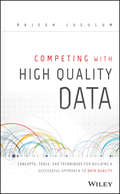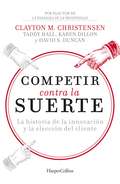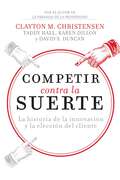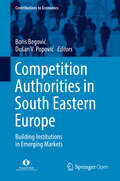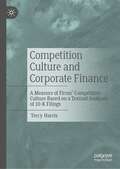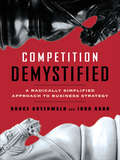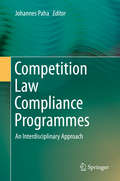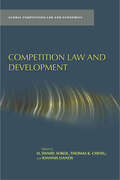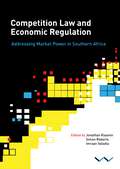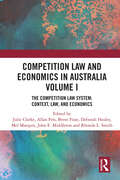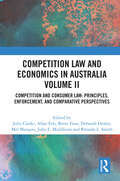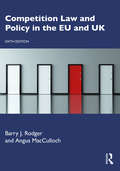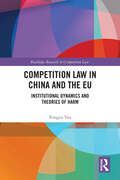- Table View
- List View
Competing through ICT Capability
by Mitsuru KodamaProposes that video communications tools are a form of infrastructure that enhance the creation of new knowledge which transcends space and time in business activities. Illustrates that the dynamic relationship of four elements of ICT capability promote the formation of business networks and the development of knowledge communities.
Competing to Shape the Future
by Gary Hamel C. K. PrahaladThis chapter discusses what must be done to turn industry foresight into reality and outpace competitors on the road to market leadership.
Competing with Giants: Survival Strategies for Local Companies in Emerging Markets
by Niraj Dawar Tony FrostThe arrival of a multinational corporation often looks like a death sentence to local companies in an emerging market. After all, how can they compete in the face of the vast financial and technological resources, the seasoned management, and the powerful brands of, say, a Compaq or a Johnson & Johnson? But local companies often have more options than they might think, say the authors. Those options vary, depending on the strength of globalization pressures in an industry and the nature of a company's competitive assets. In the worst case, when globalization pressures are strong and a company has no competitive assets that it can transfer to other countries, it needs to retreat to a locally oriented link within the value chain. But if globalization pressures are weak, the company may be able to defend its market share by leveraging the advantages it enjoys in its home market. Many companies in emerging markets have assets that can work well in other countries. Those that operate in industries where the pressures to globalize are weak may be able to extend their success to a limited number of other markets that are similar to their home base. And those operating in global markets may be able to contend head-on with multinational rivals. By better understanding the relationship between their company's assets and the industry they operate in, executives from emerging markets can gain a clearer picture of the options they really have when multinationals come to stay.
Competing with High Quality Data: Concepts, Tools, and Techniques for Building a Successful Approach to Data Quality
by Rajesh JugulumCreate a competitive advantage with data quality Data is rapidly becoming the powerhouse of industry, but low-quality data can actually put a company at a disadvantage. To be used effectively, data must accurately reflect the real-world scenario it represents, and it must be in a form that is usable and accessible. Quality data involves asking the right questions, targeting the correct parameters, and having an effective internal management, organization, and access system. It must be relevant, complete, and correct, while falling in line with pervasive regulatory oversight programs. Competing with High Quality Data: Concepts, Tools and Techniques for Building a Successful Approach to Data Quality takes a holistic approach to improving data quality, from collection to usage. Author Rajesh Jugulum is globally-recognized as a major voice in the data quality arena, with high-level backgrounds in international corporate finance. In the book, Jugulum provides a roadmap to data quality innovation, covering topics such as: The four-phase approach to data quality control Methodology that produces data sets for different aspects of a business Streamlined data quality assessment and issue resolution A structured, systematic, disciplined approach to effective data gathering The book also contains real-world case studies to illustrate how companies across a broad range of sectors have employed data quality systems, whether or not they succeeded, and what lessons were learned. High-quality data increases value throughout the information supply chain, and the benefits extend to the client, employee, and shareholder. Competing with High Quality Data: Concepts, Tools and Techniques for Building a Successful Approach to Data Quality provides the information and guidance necessary to formulate and activate an effective data quality plan today.
Competing: Understanding and Winning the Strategic Games We All Play
by Harvey L. RubenCompetition is an inescapable fact of life. From the nursery to the nursing home, from the bedroom to the boardroom, in politics and business and school and sports and everyday conversation, human beings are in constant competition with each other. We compete for jobs, grades, social position, sex, friendship, money, power, even love. So pervasive is the competitive urge that it frequently governs our behavior even when we are unaware of its influence. From the time we are very small, it is a fundamental aspect of the process by which we develop our self-esteem, our social assurance, our very identity. Competition is unavoidable.
Competir contra la suerte: La historia de la innovación y la elección del cliente
by Clayton M. Christensen¿Las empresas saben cómo crecer? ¿Cómo pueden crear productos que están seguros de que los clientes quieren comprar? ¿Puede la innovación ser más que un juego de éxito? El profesor Clayton Christensen de la Escuela de Negocios de Harvard tiene la respuesta. Hace una generación, Christensen revolucionó los negocios con su innovadora teoría de la innovación disruptiva. Ahora, él va más allá, ofreciendo nuevas y poderosas ideas. Después de años de investigación, Christensen ha llegado a una conclusión crítica: Los clientes no compran productos o servicios; ellos los "contratan" para hacer un trabajo. Comprender qué hace que los clientes "contraten" un producto o servicio, hará que cualquier empresa puede mejorar su historial de innovación, creando productos que los clientes no solo quieran contratar, sino que pagarán precios más altos para llevarlos a sus vidas; por ejemplo: Amazon, Intuit, Uber, Airbnb y Chobani, por nombrar solo algunos. Pero este libro no se trata de celebrar estos éxitos, se trata de predecir nuevos.Este libro establece cuidadosamente el marco provocativo de Christensen, que proporciona una explicación completa de la teoría y por qué es predictivo, cómo usarlo en el mundo real y, lo más importante, cómo no desperdiciar la información que proporciona.
Competir contra la suerte: La historia de la innovación y la elección del cliente
by Clayton M. Christensen Karen Dillon Taddy Hall¿Las empresas saben cómo crecer? ¿Cómo pueden crear productos que están seguros de que los clientes quieren comprar? ¿Puede la innovación ser más que un juego de éxito? El profesor Clayton Christensen de la Escuela de Negocios de Harvard tiene la respuesta. Hace una generación, Christensen revolucionó los negocios con su innovadora teoría de la innovación disruptiva. Ahora, él va más allá, ofreciendo nuevas y poderosas ideas. Después de años de investigación, Christensen ha llegado a una conclusión crítica: Los clientes no compran productos o servicios; ellos los "contratan" para hacer un trabajo. Comprender qué hace que los clientes "contraten" un producto o servicio, hará que cualquier empresa puede mejorar su historial de innovación, creando productos que los clientes no solo quieran contratar, sino que pagarán precios más altos para llevarlos a sus vidas; por ejemplo: Amazon, Intuit, Uber, Airbnb y Chobani, por nombrar solo algunos. Pero este libro no se trata de celebrar estos éxitos, se trata de predecir nuevos.Este libro establece cuidadosamente el marco provocativo de Christensen, que proporciona una explicación completa de la teoría y por qué es predictivo, cómo usarlo en el mundo real y, lo más importante, cómo no desperdiciar la información que proporciona.Competing Against LuckCompanies know how to grow? How can they create products that they are sure customers want to buy? Can innovation be more than a successful game? Professor Clayton Christensen of the Harvard Business School has the answer. A generation ago, Christensen revolutionized business with his groundbreaking theory of disruptive innovation. Now, he goes further, offering powerful new insights.After years of research, Christensen has come to a critical conclusion: Customers don't buy products or services; they "hire" them to do a job. Understanding what makes customers "hire" a product or service will help any company improve its innovation record, creating products that customers not only want to hire, but will pay higher prices to bring into their lives; for example: Amazon, Intuit, Uber, Airbnb and Chobani to name just a few. But this book isn't about celebrating these successes, it's about predicting new ones.This book carefully lays out Christensen's provocative framework, providing a comprehensive explanation of the theory and why it is predictive, how to use it in the real world, and most importantly, how not to waste the information it provides.
Competition Authorities in South Eastern Europe: Building Institutions in Emerging Markets (Contributions to Economics)
by Boris Begović Dušan V. PopovićThis open access book provides answers to key open questions concerning competition policy in emerging economies, with a focus on South Eastern Europe. The contributions address two major issues. One is the design of competition policy and the national competition authorities that enforce it, including the topics of competition advocacy and state aid control; the other is the use of economic methods in competition law enforcement, especially in the cases of relevant market definition and merger control. Many lessons learned in the countries of South Eastern Europe can be applied to the emerging markets of other regions. As such, the findings presented here will be highly relevant for officials and staff at national competition authorities, advisers to legislators shaping national competition policy, competition law professionals, and university students alike.
Competition Culture and Corporate Finance: A Measure of Firms’ Competition Culture Based on a Textual Analysis of 10-K Filings
by Terry HarrisThis book introduces a measure of firms’ competition culture based on a textual analysis and natural language processing (NPL) of firms’ 10-K filings. Using this measure, the book explores the relationship between competition culture and various phenomena in corporate finance, specifically, institutional ownership structure, stock return performance, idiosyncratic stock price crash risk, meeting/beating analysts’ earnings expectations, and earnings management activity, for a large sample of US-based financial and non-financial firms. In particular, the book provides evidence that transient institutional ownership intensifies firms’ competition culture, while dedicated institutional ownership lessens it. In addition, the book’s findings suggest that firms with greater levels of competition culture achieve higher levels of short-term stock return performance, experience greater incidence of idiosyncratic stock price crashes, and are more prone to meet/beat analysts forecast and engage in accruals-based earnings manipulation. Finally, the book examines the role played by competition culture in financial firms (i.e., banks). Specifically, the book explores the effect of competition culture on bank lending and shows that banks with greater levels of competition culture are generally more prone to engage in procyclical lending activity. The findings of the book have significant policy implications and will be of interests to regulators, accounting standard-setters, managers and those charged with firm governance, career academics and researchers, graduates, and those generally interested in the role played by corporate culture in the related fields of finance, economics, and accounting.
Competition Demystified: A Radically Simplified Approach to Business Strategy
by Judd Kahn Bruce C. GreenwaldBruce Greenwald, one of the nation?s leading business professors, presents a new and simplified approach to strategy that cuts through much of the fog that has surrounded the subject. Based on his hugely popular course at Columbia Business School, Greenwald and his coauthor, Judd Kahn, offer an easy-to-follow method for understanding the competitive structure of your industry and developing an appropriate strategy for your specific position. Over the last two decades, the conventional approach to strategy has become frustratingly complex. It?s easy to get lost in a sophisticated model of your competitors, suppliers, buyers, substitutes, and other players, while losing sight of the big question: Are there barriers to entry that allow you to do things that other firms cannot?
Competition Grid: Experimenting With and Within Architecture Competitions
by Maria Theodorou Antigoni KatsakouThe Competition Grid: Experimenting With and Within Architecture Competitions is a comprehensive review of architectural competitions. Each section features international research overviews as well as lively discussions with experts that draw on first-hand experience of the competition process.
Competition Law Compliance Programmes: An Interdisciplinary Approach
by Johannes PahaThis book reviews and presents antitrust law compliance programmes from different angles. These programmes have been increasingly implemented and refined by firms over recent years, and various aspects of this topic have been researched. The contributions in this book extend beyond the treatment of legal issues and show how lawyers, economists, psychologists, and business scholars can help design antitrust law compliance programmes more effectively and run them more efficiently.
Competition Law and Democracy: Markets as Institutions of Antipower (Global Competition Law and Economics Policy)
by Elias DeutscherExamining the normative foundations of US antitrust and EU competition law, Elias Deutscher argues that the idea of a competition-democracy nexus rests on a commitment to a republican understanding of economic liberty. The book uses this republican concept of economic liberty to analyse how US antitrust and EU competition law embodied a competition-democracy nexus and explains how the turn of competition law toward a more economic approach has led to its decline. The book offers proposals for how the nexus can be revived to allow competition law to address contemporary concerns about the concentration of corporate power.
Competition Law and Development
by Ioannis Lianos D. Daniel Sokol Thomas K. ChengThe vast majority of the countries in the world are developing countries—there are only thirty-four OECD (Organisation for Economic Co-operation and Development) countries—and yet there is a serious dearth of attention to developing countries in the international and comparative law scholarship, which has been preoccupied with the United States and the European Union. Competition Law and Development investigates whether or not the competition law and policy transplanted from Europe and the United States can be successfully implemented in the developing world or whether the developing-world experience suggests a need for a different analytical framework. The political and economic environment of developing countries often differs significantly from that of developed countries in ways that may have serious implications for competition law enforcement. The need to devote greater attention to developing countries is also justified by the changing global economic reality in which developing countries—especially China, India, and Brazil—have emerged as economic powerhouses. Together with Russia, the so-called BRIC countries have accounted for thirty percent of global economic growth since the term was coined in 2001. In this sense, developing countries deserve more attention not because of any justifiable differences from developed countries in competition law enforcement, either in theoretical or practical terms, but because of their sheer economic heft. This book, the second in the Global Competition Law and Economics series, provides a number of viewpoints of what competition law and policy mean both in theory and practice in a development context.
Competition Law and Economic Regulation
by Niamh DunneNiamh Dunne undertakes a systematic exploration of the relationship between competition law and economic regulation as legal mechanisms of market control. Beginning from a theoretical assessment of these legal instruments as discrete mechanisms, the author goes on to address numerous facets of the substantive interrelationship between competition law and economic regulation. She considers, amongst other aspects, the concept of regulatory competition law; deregulation, liberalisation and 'regulation for competition'; the concurrent application of competition law in regulated markets; and relevant institutional aspects including market study procedures, the distribution of enforcement powers between competition agencies and sector regulators, and certain legal powers that demonstrate a 'hybridised' quality lying between competition law and economic regulation. Throughout her assessment, Dunne identifies and explores recurrent considerations that inform and shape the optimal relationship between these legal mechanisms within any jurisdiction.
Competition Law and Economic Regulation in Southern Africa: Addressing Market Power in Southern Africa
by Jonathan Klaaren Simon Roberts Imraan ValodiaShaping markets through competition and economic regulation is at the heart of addressing the development challenges facing countries in southern Africa. The contributors to Competition Law and Economic Regulation: Addressing Market Power in southern Africa critically assess the efficacy of the competition and economic regulation frameworks, including the impact of a number of the regional competition authorities in a range of sectors throughout southern Africa. Featuring academics as well as practitioners in the field, the book addresses issues common to southern African countries, where markets are small and concentrated, with particularly high barriers to entry, and where the resources to enforce legislation against anti-competitive conduct are limited. What is needed, the contributors argue, is an understanding of competition and regional integration as part of an inclusive growth agenda for Africa. By examining competition and regulation in a single framework, and viewing this within the southern African experience, this volume adds new perspectives to the global competition literature. It is an essential reference tool and will be of great interest to policymakers and regulators, as well as the rapidly growing ecosystem of legal practitioners and economists engaged in the field.
Competition Law and Economics in Australia, Volume I: The Competition Law System: Context, Law and Economics
by Brent Fisse Mel Marquis Deborah Healey Julie Clarke Rhonda L. Smith Allan Fels John E. MiddletonMarking the 50-year anniversary of modern statutory competition law in Australia, this two-volume set brings together more than 40 leading experts to discuss the most important issues and developments arising under Australian competition law, economics, and policy.This publication discusses current reforms and reviews the impact of competition law and policy in the Australian economy over the last 50 years, since the enactment of the Trade Practices Act 1974. Contributors examine the legacy of this landmark legislation, important precedents and cases that have shaped contemporary Australian competition law, as well as the substantive, procedural, and institutional features in need of revision. Volume I focuses on the history and context of Australian competition law, the courts and tribunal, and the competition system established by the Competition and Consumer Act. Volume II assesses consumer protection law, the digital economy, enforcement, remedies and sanctions, and the Australian competition regime from a comparative perspective.This volume, alongside its companion, Competition and Consumer Law: Principles, Enforcement, and Comparative Perspectives, is an authoritative treatise that will interest the broader competition law and policy community around the world. Together, they provide essential insights for academics, researchers, practitioners, policymakers, and regulators.
Competition Law and Economics in Australia, Volume II: Competition and Consumer Law: Principles, Enforcement, and Comparative Perspectives
by Brent Fisse Mel Marquis Deborah Healey Julie Clarke Rhonda L. Smith Allan Fels John E. MiddletonMarking the 50th anniversary of modern statutory competition law in Australia, this two-volume set brings together more than 40 leading experts to discuss the most important issues and developments arising under Australian competition law, economics, and policy.This publication discusses current reforms and reviews the impact of competition law and consumer law in the Australian economy over the last 50 years, since the enactment of the Trade Practices Act 1974. Contributors examine the legacy of this landmark legislation, important precedents and cases that have shaped contemporary Australian competition law, as well as the substantive, procedural, and institutional features in need of revision. Volume I focuses on the history and context of Australian competition law, the courts and tribunal, and the competition system established by the Competition and Consumer Act. Volume II discusses key issues relating to consumer protection law, the digital economy, enforcement, remedies, and sanctions. It also considers the Australian competition regime from a comparative perspective. This volume, alongside its companion, The Competition Law System: Context, Law and Economics, is an authoritative treatise that will interest the broader competition law and policy community around the world. Together, they provide essential insights for academics, researchers, practitioners, consumer associations, policymakers, and regulators.
Competition Law and Financial Crime: A Comparative Analysis of International Responses to Market Manipulation (The Law of Financial Crime)
by Diana JohnsonFinancial crime is a significant drain on economies across the world. This book looks at one aspect of financial crime, that of benchmark interest rate manipulation by competing banks, with the aim of identifying the best approach for the United Kingdom to take to the enforcement of laws against future benchmark manipulation.The manipulation of any benchmark interest rate by bankers, colluding for their own gain, is likely to negatively affect a large proportion of the population, as many people have loans pegged to a benchmark interest rate. This monograph investigates the approach the UK took to enforcing action against the benchmark manipulation which took place in the London Interbank Offered Rate and the Foreign Exchange benchmark manipulation scandals. As part of this investigation, the approaches taken in the European Union and the United States of America are examined and compared to the approach taken in the UK for the same crime to draw conclusions and make recommendations to improve the UK approach for future instances of benchmark manipulation. The work fills an important gap in the literature by comparing and evaluating the laws and enforcement policies pertaining to the use of competition law in counteracting benchmark manipulation in the UK, EU and US. It argues that competition law is an effective enforcement tool when used in the financial services sector and that it provides regulators with a wide range of enforcement options when a breach of competition law is established.The book will be a valuable resource for academics, researchers and policymakers working in the areas of financial crime, competition law, comparative law and criminal justice.
Competition Law and Financial Services (Routledge Research in Finance and Banking Law)
by David HarrisonCompetition law underpins the market economy by prohibiting anti-competitive agreements and practices, and the abuse of dominant positions in the market. Until the financial crisis it was widely assumed that the financial services industry was highly competitive. This book explores the extent to which this is the case. By analysing crisis and pre-crisis competition law cases and examples from the UK, the EU and around the world, David Harrison asks whether there exists good reason for financial services to be treated differently from the rest of the market economy. The theory of market efficiency is not borne out in practice. He particularly draws upon John Maynard Keynes in examining the differences between price mechanisms in product markets for "normal" goods, and price mechanisms in financial and investment markets where expectations of the future tend to play a greater role, leading to greater price fluctuations. In this evaluation, the book examines aspects of the practical functioning of capital markets such as the phenomenon of herding behaviour by financial participants, how short-term behaviour by intermediaries can be to the disadvantage of savers and productive investment, the relationship between investment markets and product markets and the extent to which the same competition rules apply to undertakings involved in both. The book will be invaluable to students, researchers and practitioners of banking and finance law, and commercial and competition law. .
Competition Law and Policy in the EU and UK
by Barry Rodger Angus MacCullochCompetition Law and Policy in the EU and UK provides a focused guide to the main provisions and policies at issue in the EU and UK, including topics such as enforcement, abuse of dominance, anti-competitive agreements, cartels, mergers, and market investigations. The book’s contents are tailored to cover all major topics in competition law teaching, and the authors’ clear and accessible writing style offers an engaging and easy to follow overview of the subject for course use. The fifth edition provides a full update for this well-established title, presenting and contextualising the impact of key cases, as well as changes to enforcement practice, and at a legislative and institutional level. There are new, separate chapters in this edition on private enforcement and UK market investigations to reflect the increasing significance of these key areas of competition law practice. Competition Law and Policy in the EU and UK integrates useful pedagogical features to help clarify topics and reinforce important points: chapter overviews and summaries highlight the key points to take away from each chapter to structure student learning discussion questions facilitate self-testing and seminar discussions of the major issues covered in each chapter, to help reinforce understanding of these topics further reading lists additional resources in order to guide research and develop subject knowledge a new glossary provides succinct explanations of competition law terminology, ideal for those studying the topic for the first time Clear, focused and student-friendly, this title offers a comprehensive resource for students taking competition law courses, and is supported online by updates to the law offered on Angus MacCulloch’s blog, Who’s Competing (http://whoscompeting.wordpress.com/).
Competition Law and Policy in the EU and UK
by Angus Macculloch Barry J. RodgerCompetition Law and Policy in the EU and UK provides a focused guide to the main provisions and policies at issue in the UK and EU, including topics such as anti-competitive agreements, abuse of dominance, mergers and Brexit. The book’s contents are tailored to cover all major topics in competition law teaching, and the authors’ clear and accessible writing style offers an engaging and easy-to-follow overview of the subject for course use. The sixth edition provides a full update for this well-established title and takes recent developments into account, including those in the case law surrounding the concept of ‘object’ agreements under Art 101 TFEU, the concept of abuse under Art 102 TFEU, the treatment of online multi-sided platform markets, and the development of private enforcement. Chapters focus on the substantive laws of the UK and EU and demonstrate how competition law affects business including co-ordinated action, pricing behaviour, takeovers and mergers. Information is presented within a structured framework, complete with discussion of the UK enforcement structures following the UK’s withdrawal from the EU. The book includes a wealth of pedagogical features, including chapter overviews and summaries, discussion questions and further reading. Clear, focused and student-friendly, this book offers a comprehensive resource for students taking competition law courses and will be of interest to postgraduate students and legal professionals looking for an introduction to the topic.
Competition Law and Policy in the Japanese Pharmaceutical Sector (Kobe University Monograph Series in Social Science Research)
by Masako Wakui Akira Negishi Naoko MariyamaThis is the first book published that focuses on competition law and policy in the Japanese pharmaceutical sector. It consists of chapters written and edited by academics who research the industry from various perspectives, including economics, competition law, pharmaceutical regulations, and intellectual property law. Competition policies involving pharmaceutical products attract attention from academics and policymakers worldwide. The pharmaceutical industry is regulated by drug laws that vary from country to country and are affected by differing practices and industrial structures. The book begins by examining drug regulations and trade practices in the industry that are peculiar to Japan and its healthcare system. It then presents the Japanese Antimonopoly Act and cases involving it, and discussions of current competition law issues in the Japanese pharmaceutical industry. The book also discusses innovation and intellectual property and economic analyses of pharmaceutical regulations and drug discovery. The chapters include comparative studies on Japanese regulations vs. those in the European Union and the United States. Japan is one of the biggest pharmaceutical markets in the world. With this in mind, the book provides “one-stop shopping” for anyone interested in pharmaceutical regulations in the country. Covering the basics but extending to in-depth explorations of complex problems, this book appeals not only to students and academics, pharmaceutical companies and regulators, but also to those dealing with real-world policy issues that encompass competition policy, intellectual property, and pharmaceutical regulation.Chapter 11 is available open access under a Creative Commons Attribution 4.0 International License via link.springer.com
Competition Law in China and the EU: Institutional Dynamics and Theories of Harm (Routledge Research in Competition Law)
by Xingyu YanThis book presents a comprehensive review of the Chinese and European responses to the abuse of market dominance, with a focus on the impact of antitrust institutional dynamics on enforcement decisions.It uses the methods of functional comparison and case analysis to investigate how theories of harm relating to specific types of abuse differ within and across competition law regimes due to institutional dynamics. The Chinese and EU competition law regimes serve as excellent examples for this investigation because they have similar substantive laws on paper but vastly different institutional settings. The book examines—first individually and then comparatively—how the distinct institutional dynamics in the Chinese and EU regimes shape the development of theories of harm.This volume will appeal to competition law scholars, students, and practitioners seeking a more nuanced understanding of how competition law works in the EU and China. It will also interest scholars trying to approach the Chinese legal system from an engaging rather than alienating standpoint.
Competition Law in China: A Law and Economics Perspective
by Jingyuan MaThis book offers a comprehensive introduction to the developmental history and structural framework of Chinese competition law from a law and economics perspective. It examines the philosophical foundations, the substantive law, and enforcement issues concerning competition law and policy in China by pursuing an economic and comparative approach. Further, the book presents and analyzes competition cases involving monopolistic agreements, abuse of dominant position, and concentration. The book will help professionals and business practitioners to understand the distinct features of competition law and policy in China, and how the substance and enforcement of the law can be compared with competition regulations in the US and EU from an economic perspective. Given its scope, it offers a valuable guide for academic, public sector and professional audiences alike, and will appeal to researchers, students and anyone with an interest in economic law and policy in China. The book can also be used as reading material to accompany courses such as China’s Competition Law and Policy, Comparative Competition Law, and Market Regulation in China for foreign students studying Chinese law and policy at the undergraduate, graduate and doctoral levels.


